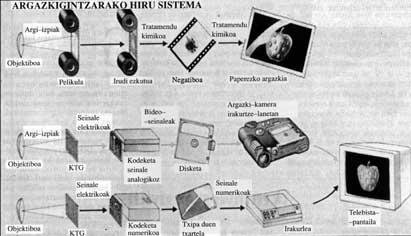Production of synthetic images
1988/04/01 Arizkorreta, Alberto Iturria: Elhuyar aldizkaria
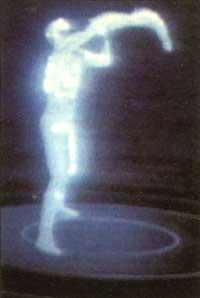
And what is this Computer Graphics?. Your translation tells us that it is about making images or computer graphics. However, this terminology cannot be considered very suitable, since, in short, the graph is not a mobile show in itself and the particularity and the most striking problem of this technology is its movement and the 3rd dimension of computer-generated images. But let's not go ahead and go step by step.
In the following pages I will try to bring you closer to the origins of this technique of creation.
The first images created by computer date back to the 1950s. From then until now this technique has been developed according to the improvements that were taking place on the computer.
The computer image has always been linked to a television screen, and as you all know, the encoded signal created by it and its definition gives us that real aspect. Television currently works on 625 lines. However, the day we will see more credible and assimilated to cinema with 1,200 lines and a more real image is not far.
Let's say, however, that the computer instead of working by lines does it by PIXEL. The PIXEL is a point where the computer can act independently on each point. The more Pixel, the higher your image quality and, of course, the higher your price.
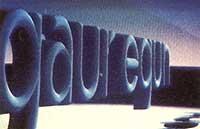
To make good the image of a computer, both in cinema and television, must have a minimum resolution of 1.280 by 1.024 PIXELS, which indicates that the computer influences 250,000 points.
But with the computer, how does the image arise?
Creating synthetic images
The creation of images in two dimensions (2-D) and/or clearly, in a simple and simple drawing (in practice it does not matter to be on paper and/or television monitor), is the first thing we will see.
However, the limits of such images are high. In addition to the appearance of the three-dimensional, we cannot get other perspectives and drawn sections. No other properties (volume, stiffness, etc.) calculate.
These images can be created in two different ways:
- Live by computer,
- Via a peripheral. A) Directly by computer
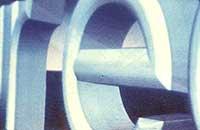
Using the keyboard we will introduce some variables in the ±X and ±Y axis of the imaginary plane. Of course, the imaginary plane is that of the screen. In this first use
- point script
- and we will work only with the arches.
And with them we can get an image on the monitor. They are usually simple, geometric figures.
The rectangle would be represented like this.
Now we can apply different functions to this rectangle. Normally these functions depend on the operating capacity of the computer.
The most frequent variations in the plane are:
- Homothetia: Extended or reduced image.
- Symmetry: Reverse image, like mirror effect. B) Via a peripheral
Through them we can start from a previous image and access the computer to process it, using it as a rectangle created above.
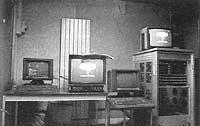
The most common computer on peripherals is the 2-D pallet or electronic brush. At this level there are authentic pitchers in the professional market such as PaintBox, Chyron-4, Graff-9, etc. All of them are designed to be used in television works. In these cases the pallet creates the image and changes the computer. Normally and with the computerized system the pallet is replaced by the digitizer. There are also 3-D pallets (THREE DIMENSIONS). I had permission to use one of the CCETT (Centre Comun d'Etudes de la Telecomunication et Television) in France.
On the other hand, and for example, we could start from a photo. Here, using a camera, we would take the image and send it to the computer, digitizing it and saving it for another use.
So, gradually movement, color, etc. to give it gets complicated. So far we have worked with the ziri. A good example of wedge work is the film TRON, a world still naked of synthetic images. The most curious example is in the Fila-7 Program of T.V.E., prepared by a Madrid company.
Chronologically the next step was to create three-dimensional synthetic images. Here comes into play a new coordinate “Z”. This will give us the volume of the images generated. This 3-D system is also called Geometric Modeling.
Now the creation of a thing is much more worked, because its definition indicates that it is bigger and more precise.
These things,
- Surface volume, regular polygon, etc.
- and through complex mathematical operations
we can define them.
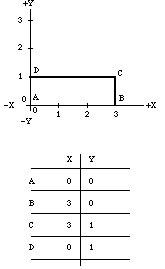
To make it somewhat more understandable and visual, we will focus on the polygon system, one of the easiest for it.
One thing arises by adding and adding polygons. For example, E.S. from the Gaur Egun section the logo has more than 10,000 polygons. If we could see Ga enlarged, we would see a network of spiders with thousands of elements joined together.
Thus, the higher the power of the computer, the more polygons you can process to create the image, and this will be more complex.
The computer we used, if it takes 5 minutes to process 15,000 polygons, the X-MP-22 computer from Digital Productions processes a million polygons in a minute and a half. If you want to know its price, we will say that it is worth more than two billion pesetas.
Well, suppose that after performing all the operations we have the images we want. How can we see them? How are we going to move it?
Seeing the synthetic image on a monitor is quite simple thanks to a tool placed between the computer and the monitor, the interface. But seeing the moving image is another story, because computers still do not work in real time, but by processing the images that a program has individually. This is the traditional system that is always used in animation here.
Let us put, for example, the most complex chapter that has so far been done in the E.T.B. by computer, the section manager of the program TXORIA DUT MAITE.
The chapter lasts 34 seconds. Considering that there are 25 images per second, the computer provides us with an amount of 850 different images processed one by one.
Each of these 850 images passes to a high resolution monitor of 1,200 stripes during processing. There are also 5,000 lines. They are photographed by a properly prepared film camera. So up to 850. Then the film is revealed, it goes from the telecable to the video, it gets music and eup! !, we have the chapter in motion. It is a wonderful contrast to unite these two techniques. One so modern and the other, the cinema, so old.
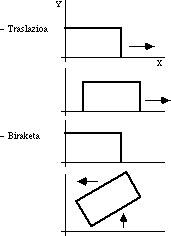
The computer also offers us a single imaginary camera option, the camera that enters into the television of Txoria Dut Maite or that follows in his comeries the paper plane, even if it is not real in reality.
And just like we play with an imaginary camera, with the imaginary points of light we also do, because if we were not without lighting we would not see anything. The light points are also programmed in the axes X, Y, Z, where shadows, reflections, etc. are programmed. creating.
But from now on it is very complicated and here we have only wanted to give a small explanation of the authenticity of those images that are not real. That's why the possibility of watching another new film by Marilyn Monroe is not far away. We will see a fime that I had never recorded, but our eyes will not mark differences between the authentic Marily and this computerized Marilyn. And we don't say so, because they are already working in the US.
In E.T.B. we have at this moment two low examples of three-dimensional synthetic images: Chapters of "Gaur Egun" and "Txoria Dut Maite".
But of these we will speak in another.
New system
Everything that has been exposed is somehow obsolete. As mentioned above, we are already working on creating more credible and complicated images.
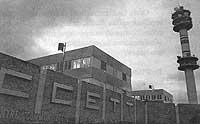
A few months ago I was in a course in Rennes (France) and had the opportunity to learn about the new French system. This system is being investigated by the organization CCETT, known as RAY CASTING. With this system very complex figures are created that we would never have been able to achieve with the traditional system of sphere, polygon, wedge, etc. The work sources of the computer are totally different, as long as necessary, etc. With all my good will I requested permission from the system to take a picture, but it was impossible, because they told me it was a high-level technology that had to be taken care of. However, we were presented with FIVE seconds of a promotional clip. It was five surprising seconds.
If we start thinking, all these complex systems have not been designed to make animated nonsense.
However, in this world the advances occur day by day. 7th International New Images, held this year in Monte Carlo. At the Forum, the Japanese have proposed the creation of images through the laser. And it doesn't seem that the question remains there!

Gai honi buruzko eduki gehiago
Elhuyarrek garatutako teknologia





